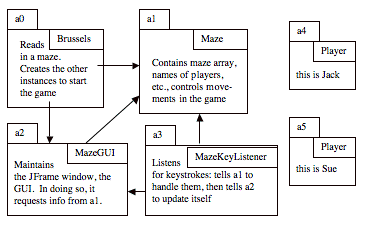 Preamble
Preamble Preamble
Preamble We explain a game that you will write.
Then, we explain what you have to do for this assignment, which gives you practice
using two-dimensional arrays, loops, and if-statements and working with static
information. You will also see GUIS (graphical user interfaces) at work, you
will see how a program that uses a GUI can be structured, and you will learn
how a Java program "listens" for
keystrokes and responds to them.
Spend time reading this handout so that you thoroughly understand what we are asking for. Do this before you start programming! Take notes as you read.
You will write a two-player game. It is not the game called Sprouts (click on such links, please) that was created by John Conway. Jack and Sue are caught in a maze, and they frantically run around and eat Brussels sprouts.
The mazeTo the right is a sample maze. Jack ( |
------- |
The maze is given in a file, with one line of the file for each line of the maze. The maze is rectangular. Jack and Sue must appear inside the maze. The outside edges of the maze are walls, as indicated above: a hallway, a Brussels sprout, Jack, or Sue may not be on the outside edge.
Controls The maze is displayed in a |
Jack |
Sue |
The players, Jack and Sue, move around the maze. They cannot move into walls.
If they try to move into walls, nothing happens. Jack and Sue
can occupy the same space, although if this happens only Sue will show on
the map (Jack is a gentleman). When they move over a Brussels
sprout
they eat it and the @ disappears. The game keeps track of how
many
Brussels sprouts
each has eaten. When there are no Brussels
sprouts left, the game ends a message announces how many Brussels sprouts
each player ate and who won.
You can download a finished version of this game from the website or just click here: brussels.jar (At some point, we will show you how you can make your own Java programs into jar files.) Here are two mazes that you can play with: bigmaze.txt littlemaze.txt. Put these two mazes in a directory, along with brussels.jar. When the game starts, it asks for a maze to play with, using a dialog window; use that dialog box to navigate to the appropriate directory and select one of the mazes.
 The classes
The classesThe program uses five classes, as indicated in the diagram on the right. Class
Brussels is used to read in the initial maze and create the necessary instances
of the rest of the classes.
Class Maze is the major calculator. It maintains the maze, it keeps track
of the two players and the number of sprouts still left, and it is the only
one to actually change the maze because of keystrokes. It is the engine. It
is important that Maze knows nothing about the GUI or the key listener
(see below). All it does is keep track of the maze.
Class MazeGUI is an extension of JFrame. An instance of this class maintains
the GUI. It has a procedure update(), which is called when the GUI has to
be updated; in turn, this procedure calls Maze instance a1 for information
it needs (e.g. how many Brussel Sprouts are in the maze).
Class MazeKeyListener "listens"
for keystrokes on the keyboard. When there is a keystroke, its method keyTyped(k)
is called by the system. This method figures out what key was typed and calls
a method of Maze instance a1 to handle the keystroke;
after that, it calls a2.update()
in order to change the GUI.
As you can see, each class, or instance of the class, performs its own task. In this manner, each class can be written fairly easily. When writing programs that use GUIs, one generally tries to separate the GUI maintenance from the calculation in the program, as we have done.
Download skeleton.zip and unzip it to get (1) a jar file of the game that you can play, (2) two mazes, and (3) skeletons for four classes: Brussels.java, Maze.java, MazeGUI.java, and MazeKeyListener.java. Put them all in the same directory.
Most of what we have told you thus far is just background, giving you a taste for what is to come and giving you a little idea about how GUI programs are put together. We now list the tasks to do for this assignment, in order.
Write class Player, an instance of which represents a player.
The other classes won't compile until this class is written, so don't open
the other classes in DrJava until this is written. You figure out what fields
it needs, based on the methods that it requires. Note that an instance has
no knowledge of the maze itself. It just keeps track of where the player is
and how many Brussel
Sprouts the player has eaten.
| Brussels() | Constructor: a player at position (0,0), who has eaten no brussel sprouts |
| getRow() | = the row number in which this player currently is |
| getCol() | = the column number in which this player current is |
| getNumSprouts() | = number of brussel sprouts this player has eaten |
| move(int r, int c) | Move this player to row r column c of the maze (this a procedure) |
| eatSprout() | Register that this player has eaten another sprout (this a procedure) |
Write (and test thoroughly) function getMap(String) of
class Brussels.
This method reads in a maze from a file and returns a two-dimensional
char array that contains it. Here are some points to consider.
The array cannot be created until the number of rows is known. We suggest
that you use a temporary Vector, as follows. Read the lines of
the file one by one, adding them to the Vector. Once one line has been
read, the number of columns is known. Once all the lines have been
read, the number of rows is known. So, now, create the two-dimensional array.
Then, process the elements of the Vector, one at a time, placing the characters
in it into the appropriate positions of the two-dimensional array.
Notes: A suitable method to obtain a buffered reader is already in class Brussels,
for you to use. To help you check getMap out, we have included a method
Brussels.toString.
Your next task is to write and test all the methods of class Maze. As mentioned
above, class Maze contains the methods that manipulate the internal representation
of the maze, including the positions of the two players. Besides the constructor,
there are 6 other methods bodies to write. Most of these are simple.
Important point: Note that parameter m of the constructor is a rectangular
array that contains 'S' and 'J' to mark the position of the two players. However,
when this maze is stored in field b, the 'S' and
'J' should NOT be put in b
--they should be replaced by HALL. Instead, the positions of the players are
given by the two Player objects JACK and SUE.
Important point. Do NOT use the character constants ".", "@",
etc. in writing the method bodies. Instead, rely on the static constants HALL,
SPROUT, etc. The same goes for directions. Don't use integers like -1 and +1
to indicate directions. Instead, use the static constants LEFT, RIGHT,
NOCHANGE, UP, and DOWN.
Points will be deducted if you don't follow these rules.
You last task is to write the body of method keyTyped of class MazeKeyListener.
This method is called when the JFrame window has the focus and a key is typed.
This method should determine what key was typed and perform appropriately.
If it is one of the keys szxcijkl that are part of the game, the method should
call maze.move appropriately. Note that this method has access to the two players
(using maze.JACK and maze.SUE) and also to the static constants
of Maze, like Maze.RIGHT. It should make use of the constants and not use integer
constants directly, like -1 or 0 or 1.
Once this method is working properly, you will be able to play the game with your friends. Have a good time with it.
On the CMS, submit your files Player.java and Brussels.java by midnight, 21 November.